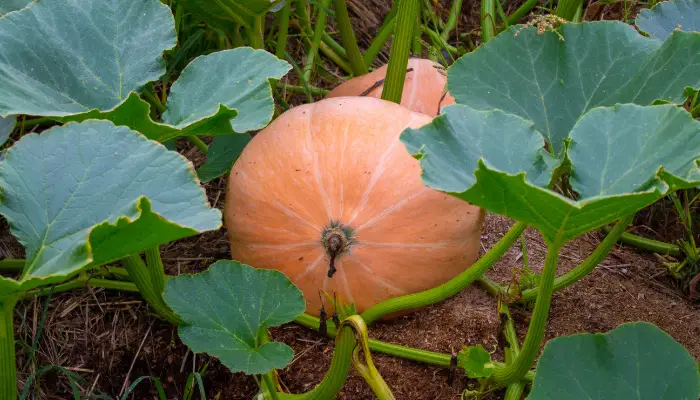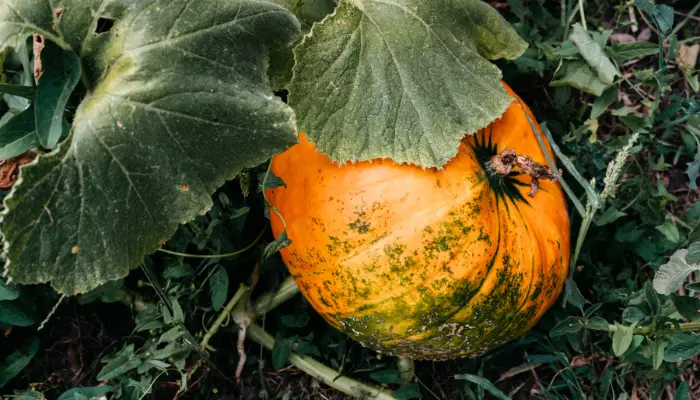Pumpkins are one of the most popular and versatile crops to grow in your garden. They can be used for carving, decorating, cooking, and even feeding your livestock. But what if you don’t have any pumpkin seeds to start with? Can you grow new pumpkins from the old ones that you harvested last year?
The answer is yes, you can! In fact, growing pumpkins from old pumpkins is a great way to reuse your pumpkins and save money on buying new seeds. However, there are some things you need to know before you try this method. In this blog post, we will explain how to grow pumpkins from old pumpkins, what the benefits and challenges of doing so are, and some tips and tricks to ensure a successful harvest.
How to Grow Pumpkins From Old Pumpkins

Growing pumpkins from old pumpkins is not very different from growing them from seeds. You just need to follow these simple steps:
- Choose a good pumpkin to use as your seed source. The best pumpkins for this purpose are those that have been left to ripen and soften on the vine, as they have more viable seeds. Avoid pumpkins that have been picked early, damaged, or diseased, as they may not germinate or produce healthy plants.
- Cut the pumpkin in half and scoop out the seeds. Rinse the seeds in a colander to remove any remaining flesh and pulp. Allow the seeds to dry completely on a paper towel or a baking sheet before planting. You can also store the seeds in a cool, dry place until you are ready to plant them.
- Prepare the soil for planting. Pumpkins need rich, well-draining soil that is full of organic matter, such as compost or aged manure. Choose a sunny location that gets at least six hours of direct sunlight per day, and make sure the soil is warm enough for germination, between 65°F and 95°F (18°C and 35°C).
- Plant the seeds either in rows or in hills, depending on how much space you have. In rows, sow the seeds 6 to 12 inches apart, and cover them lightly with soil. In hills, make mounds of soil about 4 feet apart, and plant 4 to 6 seeds per hill, about an inch deep. Water the seeds well after planting, and keep the soil moist but not soggy until they sprout.
- Thin out the seedlings once they are 2 to 3 inches tall, leaving only one or two plants per hill or per foot of row. This will give the plants enough room to grow and prevent competition for nutrients and water.
- Care for the plants as they grow by watering, weeding, fertilizing, and practicing pest control. Pumpkins need regular watering, especially during the flowering and fruiting stages, but avoid wetting the leaves and stems, as this can cause fungal diseases. Use a balanced fertilizer or compost to provide the plants with essential nutrients, and apply it every two to four weeks. Watch out for common pests and diseases that affect pumpkins, such as squash bugs, vine borers, powdery mildew, and bacterial wilt, and treat them accordingly. You can also use organic methods, such as crop rotation, companion planting, and mulching, to prevent or reduce these problems.
- Harvest the pumpkins when they are fully ripe and mature, usually in late summer or early fall. You can tell when a pumpkin is ready to harvest by its color, shape, size, and sound. A ripe pumpkin will have a deep orange color, a hard and smooth skin, a round and plump shape, and a hollow sound when tapped. To harvest a pumpkin, cut the stem about 3 to 4 inches from the fruit using a sharp knife or pruning shears. Do not pull or twist the stem, as this can damage the pumpkin and shorten its shelf life. Leave some stem attached to the pumpkin, as this will help prevent rotting and infection. Cure the pumpkins in a warm, dry, and well-ventilated place for about 10 days to harden the skin and improve the flavor and storage quality. Store the pumpkins in a cool, dark, and dry place, such as a basement or a garage, until you are ready to use them.
Benefits and Challenges of Growing Pumpkins From Old Pumpkins

Growing Pumpkins
Growing pumpkins from old pumpkins has some advantages and disadvantages that you should be aware of before you try it. Here are some of them:
Benefits
-
- You can save money by buying new seeds and reusing your pumpkins instead of throwing them away or composting them.
- You can grow pumpkins that are adapted to your local climate and soil conditions, as they have inherited the traits of their parent plants.
- You can enjoy the satisfaction and fun of growing your own pumpkins from scratch and sharing them with your family and friends.
Challenges
-
- You may not get the same variety or quality of pumpkins that you started with, as the seeds may have cross-pollinated with other pumpkins or squash in your garden or nearby. This can result in pumpkins that have different colors, shapes, sizes, or flavors than you expected. To avoid this, you can either grow only one variety of pumpkin in your garden or isolate the flowers of the pumpkins you want to save seeds from by covering them with a mesh bag or a paper cup before they open and hand-pollinating them with a soft brush or a cotton swab.
- You may not get enough seeds to plant, as some pumpkins may have fewer seeds than others, or the seeds may not be viable or healthy. To increase your chances of getting good seeds, you can select the best pumpkins from your crop and store them in a cool, dry place until you are ready to extract the seeds. You can also test the seeds for viability by placing them in a glass of water and discarding the ones that float, as they are likely to be empty or rotten.
- You may not get any pumpkins at all, as the seeds may not germinate or the plants may not produce any fruits due to unfavorable weather, soil, or pest conditions. To improve your chances of getting pumpkins, you can follow the best practices for growing pumpkins, such as choosing the right location, preparing the soil, planting at the right time, caring for the plants, and harvesting at the right time.
Tips and Tricks for Growing Pumpkins From Old Pumpkins
Growing pumpkins from old pumpkins can be a rewarding and enjoyable experience if you follow some tips and tricks that can help you get the best results. Here are some of them:
- Choose pumpkins that are suitable for your purpose, whether you want to use them for carving, decorating, cooking, or feeding. Different varieties of pumpkins have different characteristics, such as size, shape, color, texture, flavor, and nutritional value, that make them more or less suitable for different uses. For example, if you want to carve pumpkins, you should choose large, round, and smooth pumpkins, such as Jack-o-Lanterns, Howdens, or Big Max. If you want to cook pumpkins, you should choose small, sweet, and dense pumpkins, such as Sugar Pie, Baby Pam, or Cinderella. If you want to feed pumpkins, you should choose large, nutritious, and edible pumpkins, such as Connecticut Field, Long Island Cheese, or Jarrahdale.
- Choose pumpkins that are suitable for your climate and growing season, as different varieties of pumpkins have different requirements for temperature, sunlight, and frost. Some pumpkins are more tolerant of heat, cold, or drought than others, and some pumpkins need more or less time to mature than others. For example, if you live in a warm and humid climate, you should choose pumpkins that are resistant to heat and disease, such as Seminole, Cushaw, or Tromboncino. If you live in a cool and short-season climate, you should choose pumpkins that are fast-maturing and frost-hardy, such as Early Sweet Sugar Pie, Jack Be Little, or Baby Boo.
- Choose pumpkins that are suitable for your space and layout, as different varieties of pumpkins have different growth habits and patterns, such as vining, bush, or semi-bush. Some pumpkins need more or less space to grow than others, and some pumpkins can be trained to grow vertically, horizontally, or in containers. For example, if you have a large and open space, you can grow vining pumpkins, such as Atlantic Giant, Dill’s Atlantic Giant, or Prizewinner, which can spread up to 25 feet or more. If you have a small and limited space, you can grow bush or semi-bush pumpkins, such as Spookie, Small Sugar, or Autumn Gold, which can grow in a compact area of 3 to 6 feet. If you have a vertical or container space, you can grow miniature or ornamental pumpkins, such as Munchkin, Wee-B-Little, or Jack Be Quick, which can grow on trellises, fences, or pots.
Conclusion
Growing pumpkins from old pumpkins is a fun and easy way to grow your own pumpkins without having to buy new seeds every year. You can grow pumpkins from old pumpkins by following these simple steps: Choose a good pumpkin to use as your seed source, cut the pumpkin in half and scoop out the seeds, prepare the soil for planting, plant the seeds either in rows or in hills, thin out the seedlings, care for the plants, and harvest the pumpkins.




